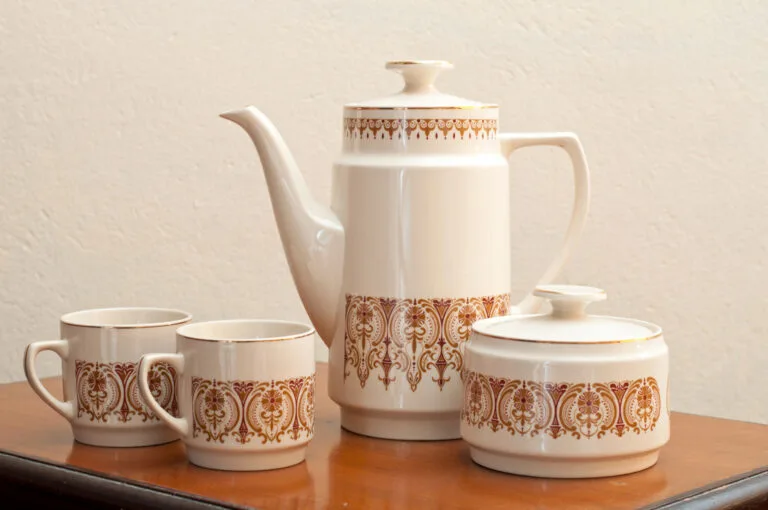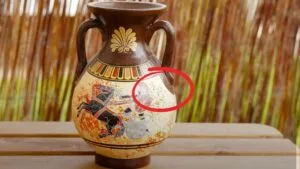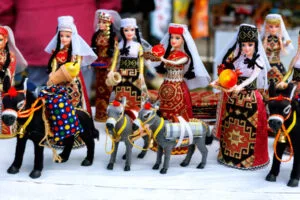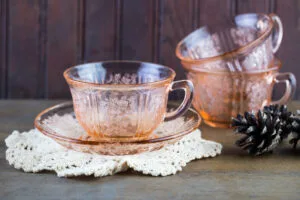We know that old bakeware is precious. But one bakeware brand that everyone has an eye for is Corningware. This brand is so popular that it gets sold out the moment it’s up for resale. But what’s the hype, you may ask? Well, Corningware is considered a ‘senti-antique!’
But that’s not it! Besides emotional values, it has some vintage, rare 50-year-old artisanal patterns on crude Pyrex. Something quite hard to find today! But if you got lucky and found one, use this value guide to know the true worth of rare Corningware patterns!
Key Takeaways
- Rare Corningware patterns have original stamps, marks, colored designs, and other filigree elements.
- Most rare Corningware products have central designs with solid, white backgrounds. But you can get the English Meadow pattern if you want a full-surface, detailed design.
- Not all Corning patterns are modern and minimal. Some traditional patterns, such as the Country Festival design, cost more due to the Asian birds and flowers.
- Get the Blue Cornflower, Nature’s Bounty, or Spice of Life pattern if you want typical veggie and herb designs.
How to Identify Rare Corningware Patterns
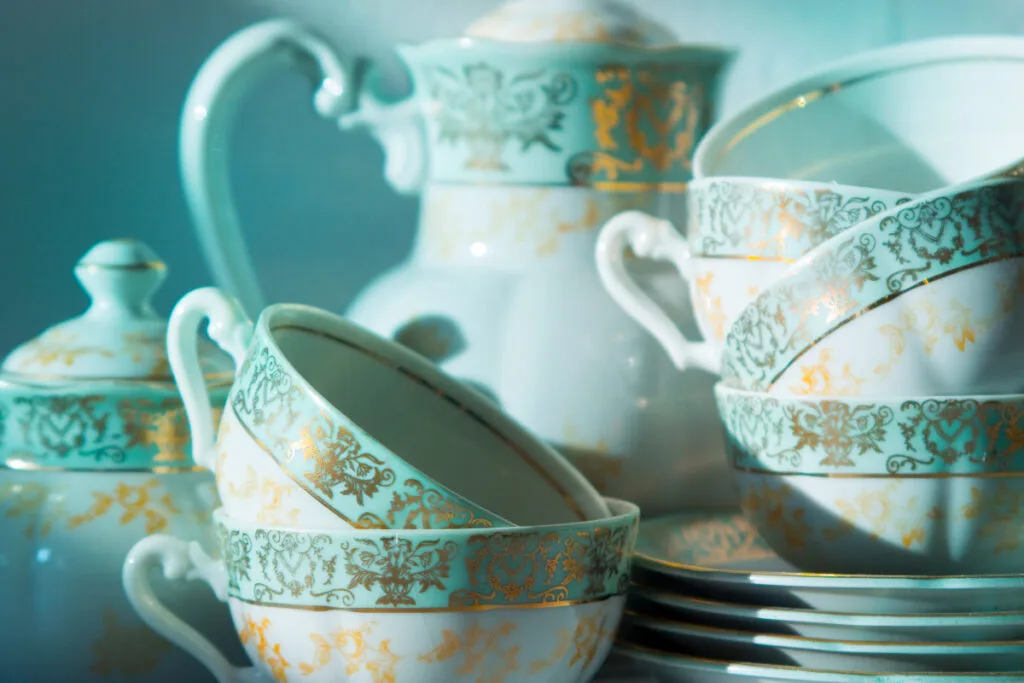
Most of the Corningware patterns look the same – floral and geometric! But, with the rare patterns, you’ll get Pyroceram’s durability and natural or social designs. So let’s get into those details for a better insight:
- Thematic elements like herbs, spices, flowers, and creepers
- Commercial and printed Corning ware and ‘Made in USA Stamps’
- Non-stick ceramic or plastic coatings that resist fading
- Superior base walls that work well in ovens and fridges
11 Rare Corningware Patterns for Every Vintage Crockery Collector
Corning didn’t obviously stick with the same pattern for ages! So, all their explorations and exclusive releases lead to some rare designs as follows:
1. Blue Cornflower Pattern
- Release Year: 1950
- Designer: Joseph Baum
One of the first Corningware patterns, Blue Cornflower, is literally a minimalist hub with a white background and three flowers. In fact, this one’s so old that it has no back stamps or item numbers! So, it’s worth more because of its handmade and slanted designs.
How to Identify?
- White walls with a central design of three blue flowers and leaves
- Block designs with white gaps and rounded edges
- Rare Pyroceram and Glossy Finishes
- Sloped sides and smaller handles for the products
| Blue Cornflower Pattern Product Name | Time Period | Estimated Value |
| Bowls – Cereal, Mixing, or Dessert | 1970 – 2000 | $1 – 30 |
| Drinking Ware – Coffee Cups, Saucers, and Coffee Pots | 1970 – 1990s | $5 – 300 |
| Plates – Bread, Dinner, and Dessert | 1950 – 2000s | $5 – 40 |
| Tableware – Salt & Pepper Jars, Creamers & Trays | 1960 – 1990 | $10 – 60 |
| Casseroles | 1970 – 2000s | $70 – 4500, as per the size and lids |
Try to get Blue Cornflower patterns made from Meissen, Cantonware, and Royal Copenhagen porcelain for a good value.
2. Starburst Pattern
- Release Year: 1959
Want a rare and premium Corningware pattern reserved for coffee percolators and oven dishes? Pick the Starbust print pattern! This one’s a rare blend of a large central star, two small stars, and metal bands. And, since it was there only till 1973, it’s rare today!
Top Identifying Features:
- Blue or Black ink stars with borders and outlines
- A slight radiating pattern with a burst-like appearance
- White base of a heat-resistant and non-stick glass
- Original ‘Corning Pyrex’ or ‘Made in USA’ stamp
| Starburst Pattern Product Name | Time Period | Estimated Value |
| Coffee Percolators or Carafes | 1960 – 1970 | $10 – 100 |
| Oven Dishes or Casseroles | 1960 – 1965 | $100 – 350 |
3. Renaissance Pattern
- Release Year: 1970
- Concept: Erik Dahlbergh’s sketch on Stockholm seaport
The Renaissance pattern is all about city designs like spires, rooftops, and terraces. So, it’s more intricate and etched than others. And since it was part of a limited-edition gift line of the 1970s, it’s a rare collectible now!
Special Features:
- Classic, etched designs with dark or charcoal-black ink
- Original base stamps, ‘Made in USA marks’ or tax scripts
- Lids with an embossed pebble texture on the underside
| Renaissance Pattern Product Name | Rough Value |
| Cookware – Casseroles, Baking Dishes & Saucepans | $60 – 200, depending on the condition of the lid |
| Serving Trays | $20 – 60, as per size |
Try to get Renaissance pattern Corning products with Milk or Pressed glass bases for good value.
4. Platinum Filigree
- Release Year: 1966 – 1968
Now, Platinum filigree isn’t made from Platinum. It’s just that it has grayish hues and intricate scrollwork patterns like metal. Apart from that, you’ll also see intricate vine motifs and borders along the seams. So, sellers charge more for such detailed and maximal designs!
Rare Traits:
- Intricate and interconnected patterns on a plain white background
- Made with superior dishwasher and oven-safe glass
- Glass knobs at the top
| Platinum Filigree Pattern Product Name | Estimated Value |
| Cookware – Casseroles & Baking Dishes | $10 – 50 |
| Serving Trays & Percolators | $60 – 150 |
5. Nature’s Bounty Corningware
- Release Year: 1971
- Designer: David D’Orazio
Nature’s Bounty is fresh veggie-themed cookware for all the farm lovers out there. Like, it has sketched veggies – carrots, mushrooms, peppers, and tomatoes on a plain white base. Plus, you’ll also see mustard pigment colors and motifs that hike its cost further.
Unique & Special Features:
- Made with heat-resistant, non-stick, and oven-safe glass
- Limited-edition set with less than 500 pieces worldwide
| Nature’s Bounty Corningware Product | Estimated Value |
| Cookware – Casseroles, Bread Pans | $10 – 100 |
| Small Dishes & Soup Plates | $5 – 30 |
6. The Medallion Pattern
- Release Year: 1972 – 1974
This one’s a rare promotional Corningware pattern for the Shell Oil Company. It has a simple company medallion with ornate flowers and petals around it. Also, this one costs more due to its pigments, symmetrical designs, and limited production of 100 – 200 pieces.
How to Identify them?
- Stylized central emblem with flowers and petals around it
- Superior, heat-resistant glass up to 450°
- Transparent glass lids and knobs on top
| Medallion Corningware Product | Estimated Value |
| Cookware – Casseroles & Oven Pans | $10 – 200 |
| Plates – Covered, Bread & Dessert | $10 – 40 |
| Bowls – Dessert & Soup | $5 – 30 |
Pick medallion patterns with green or blue colored designs for the best returns.
7. Spice of Life
- Release Year: 1970
- Designer: Mary Chase Perry Stratton
If you love colors and illustrations, you’ll surely adore this bright and vibrant pattern from Corningware. Unlike others, this one has cartoonish, watercolor motifs – artichokes, mushrooms, and garlic on a warm white base. Also, you might see some stamped herb and veggie names on the sides.
How to Spot them?
- Simple, illustrative forms of tomatoes, green peppers, artichokes, garlic, parsley, thyme, or bay leaves
- Warm white base, made from thin, borosilicate glass
| Spice of Life Pattern Product | Estimated Value |
| Dishes – Candy, Charger, Bread Plate & Platter | $5 – 80 |
| Bowls – Mixing, Dessert & Cereal | $20 – 150 |
| Drinkware – Glass, Coffee cups, Saucers, Creamers & Jars | $5 – 120 |
| Casseroles | $20 – 8,000 as per size |
| Salt & Pepper Shakers | $5 – 40 |
8. Country Festival
- Release Year: 1975
If you thought that Corning always uses modern and minimal forms, you might be wrong! This folk art design has traditional birds, flowers, and vine designs. Also, it holds more value since it resembles the barn motifs painted by the famous artist Linda Humphrey.
Rare Features:
- Traditional motifs and painted dotted eyes
- Rare, Boro-silicate glass base
| Country Festival Pattern Items | Average Value |
| Casseroles | $1 – 150 |
| Bowls – Desert, Cereal & Soup | $5 – 30 |
| Drinkware – Jars, Cups & Glass | $15 – 70 |
| Salt & Pepper Shakers | $5 – 40 |
9. French White
- Release Year: 1978
If you want a plain, white-on-white design, this French white pattern is for you! This one doesn’t have any designs or motifs. But, you’ll see embossed lines and groves on its surface. Also, this one has thicker lids, seams, and bases than others.
Key Features:
- Thick and shatter-proof Borosilicate glass base
- Linear, grooved patterns and an opaque but glossy finish
| French White Corningware Products | Time Period | Average Value |
| Casseroles & Roasting Pans | 1950 – 1970 | $5 – 200 |
| Bowls – Dessert, Cereal & Mixing | 1990 – 2000 | $10 – 70 |
| Plates – Cheese, Dessert, Dinner Plate & Platter | 1970 – 2000 | $5 – 100 |
| Drinkware – Creamers, Coffee Mugs, Cups & Pitchers | 1950 – 1990 | $5 – 70 |
| Serving Trays | 1960 – 1970 | $5 – 30 |
10. Wild Flower Corningware
- Release Year: 1977 – 1984
Wildflower is one of the rarest floral patterns from Corningware. It comes with unique but colorful orange, yellow and pink poppy and daisy designs. In fact, you’ll also see a rare, glass-ceramic base that you won’t get with other patterns. So, this one’s highly collectible!
Exclusive Features:
- Limited availability with less than 500 pieces worldwide
- Intricate and detailed pieces with shaded motifs and outlines
| Wildflower Corningware Products | Time Period | Average Value |
| Casseroles & Sauce Pans | 1950 – 1990 | $20 – 6000, as per size |
| Bowls – Cereal & Soup | 1970 – 1980 | $5 – 20 |
| Plates – Dessert & Dinner | 1970 – 1980 | $5 – 50 |
| Drinkware – Pitchers, Jars, Mugs & Saucers | 1970 – 1990 | $1 – 40 |
11. English Meadow Corningware
- Release Year: 1989 – 1994
The English Meadow pattern is the only Corningware pattern that runs all along the surface. It has leaves and vines at the top and flowers at the base. So, this one looks more detailed and complete. Also, it has both square and round bases, making it even more unique!
Rare & Top Traits:
- Durable glass ceramic base with heat-resistant and shatter-resistant coats
- Rare English country-style or European make
- Comes with extra close covers for freshness
| English Meadow Corningware Products | Time Period | Average Value |
| Casseroles & Baking Pans | 1970 – 1980 | $10 – 70 |
| Bowls – Cereal, Dessert & Soup | 1980 – 1990 | $5 – 40 |
| Casserole Dishes & DInnerware | 1970 – 1990 | $5 – 60 |
Which is the Most Popular Corningware Pattern?
The Spice of Life is the most popular Corningware pattern as of 2023. That’s because it has rare, colorful designs and thick borosilicate glass finishes that might cost up to $8,000.
Which is the Oldest Corningware Pattern?
The Cornflower Blue is the oldest Corningware pattern from the 1950s. You’ll easily spot this one by its crude Pyroceram finishes and sloped walls.
Is Old Corningware Lead-Free?
No, old Corningware isn’t lead-free and usually tests positive for 15,000 – 100,000 PPM values.
I am sure all of you must have one of the Corningware patterns back home! So, just check its designs and see if they match the above. If yes, it’s a rare, collectible pattern, and you can fetch good returns for it! If not, you can still trade it for some of the rare patterns above.
And if you want more crockery value guides for Corelle patterns, rare China patterns, and Frankoma pottery, I have shared detailed guides for you!
Note: This article is intended for informational, educational, and entertainment purposes only. Some images are illustrative and may not represent actual brands, products, or related entities. All trademarks, product names, brand logos, packaging, and other intellectual property referenced remain the exclusive property of their respective owners. Any brand mentions or references are provided solely for descriptive and educational context and do not imply any formal or commercial association.

